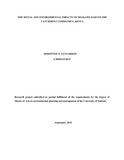| dc.description.abstract | Dams have been used for thousands of years to regulate river flows and ensure adequate supply
of water during dry periods. In the future, as population increase and water consumption rises,
many people believe there will be a need for more dams. However, in recent years proposals for
new dams have, in many places, aroused intense opposition. There are many social and
economic arguments against dams, but underpinning many of these arguments is the fact that
dams produce major ecological changes in river ecosystems. This project investigated the
environmental as well as the social impacts that had arisen from the creation of a Ndakaini dam
in Thika. The sampling procedure selected three sub-locations (Ndakaini, Kimandi, and
Makomboki) in the Gatanga Districts and the respondents were randomly selected from the three
sub-locations.
The study adopted a survey research design with a targeted population of 14,218 persons in
Muranga County, Gatanga districts. A sample size of 73 respondents was used for this study.
Primary data were gathered directly from the affected community using structured
questionnaires, interview schedule, photography and observation data collection. Analysis of the
data was done by use of SPSS. Chi square and Pearson‟s correlation were used to analyse
statistical relationships of variables. The results were presented in bar charts, percentages and
mean. From the findings, the study found out that the environmental impacts was not significant
to the livelihood of the catchment area among residents.
It also found out that the social impacts have significantly affected the Ndakaini Dam and its
catchment areas amongst residents. I finally found out that the mitigation measures are not
significant to dam conservation. The study concluded that the rate of deforestation and erosion in
the study area is linked to the methods of farming practices as well as the removal of the
catchment vegetation as part of land preparation. It also concluded that the issue of land
degradation if not appropriately dealt with in the future, it could lead to the decrease in the water
table capacity of the dams due to filling up with silt materials and the ultimate shortening of the
life span of the dams. The study recommended that afforestation with multiple-use species will
have the benefits of renewing the watershed's ability to regulate ground waters, reducing soil
erosion and producing useful commercial crops. These activities will result in the production of
significant environmental as well as socioeconomic benefits to the communities. Furthermore,health education is one of the vital instruments to reducing health problems and the dam
authority should take more responsibility in the delivery and monitoring of health education to
the surrounding communities, especially Ndakaini, Makomboki and Kimandi | en_US |

